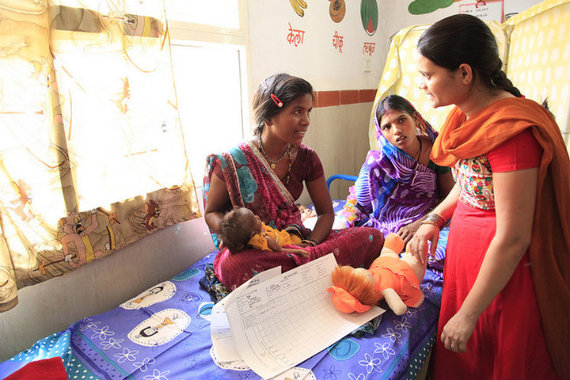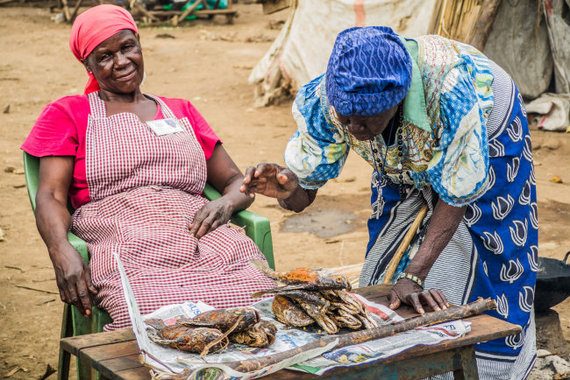Urban poverty in the Global South does not occur in a vacuum: many of the urban poor are recent migrants from rural areas who have come to the city in search of a better life. With them, they often bring traditional practices, and need access to informal support networks made up of other recent migrants to help them settle in and learn the basics of urban survival. Many continue to cultivate ties with rural areas, often to have access to reliable food supply. The following case studies explain why and how urban poverty and rural life are so closely interrelated.
 As women migrate to urban India, village customs follow, affecting maternal care choices. Urban women, even in slums, have access to doctors, clinics, and information about their health. However, women who have recently migrated from rural areas have less autonomy in their new urban environment, and are less likely to use skilled professional, safe clinics, or hospitals for giving birth. As more interventions work to improve maternal and neonatal care in urban India, it is important to recognize that as a woman's sense of autonomy grows with her urban life, so does her ability to make better, healthier decisions for herself and her family.
As women migrate to urban India, village customs follow, affecting maternal care choices. Urban women, even in slums, have access to doctors, clinics, and information about their health. However, women who have recently migrated from rural areas have less autonomy in their new urban environment, and are less likely to use skilled professional, safe clinics, or hospitals for giving birth. As more interventions work to improve maternal and neonatal care in urban India, it is important to recognize that as a woman's sense of autonomy grows with her urban life, so does her ability to make better, healthier decisions for herself and her family.
The situation in Cali shows that the subsistence of rural customs in urban settings can be an advantage. Minga (a term of Quechua origin) refers to collective work voluntarily performed by members of the community for a common good. In 2012, the Cali city government noticed this traditional practice when some communities demanded the repair of local parks, which had fallen into decay to the point of being unusable. In order to meet this demand, the city government created the program Minga al Parque to repair seven parks, which were then decorated by volunteers. Minga, a traditional and rural institution, found a new incarnation in a city as large as Cali, with a beneficial impact not only for the communities where it was kept alive, but for the city as a whole.
Most immigrants come to large cities from rural areas for largely economic reasons, usually following their friends or family members who have already settled in their new urban environment. The case of immigrants from Tegal, in Central Java, is particularly interesting, as they are greeted with support networks when they arrive in Jakarta. This group of immigrants is known for running food stalls on the streets of the capital city. Established migrants help newcomers by lending them money to open a food stall, and by teaching them how to run and grow their business. While the support remains informal, this community has proved crucial for the numerous migrants arriving from Tegal each year.
 Without the ongoing support of their rural families, migrants in Nairobi's slums would have little chance of survival. Family networks provide a crucial backbone on which migrants rely to be able to remain in the city and save money for their future. The young parents seek wealth from the city, while the older generations stay in the country and act as custodians of wealth, overseeing how remittances are invested and providing informal insurance and retirement schemes to safeguard their descendants' future. Livestock and land can provide for the people who tend for them and serve as a form of insurance policy for those living in the city. Moving to the city is a way to diversify a family's investments and make sure there are always different income streams to rely on.
Without the ongoing support of their rural families, migrants in Nairobi's slums would have little chance of survival. Family networks provide a crucial backbone on which migrants rely to be able to remain in the city and save money for their future. The young parents seek wealth from the city, while the older generations stay in the country and act as custodians of wealth, overseeing how remittances are invested and providing informal insurance and retirement schemes to safeguard their descendants' future. Livestock and land can provide for the people who tend for them and serve as a form of insurance policy for those living in the city. Moving to the city is a way to diversify a family's investments and make sure there are always different income streams to rely on.
In São Paulo, the expansion of urban agriculture is bringing greater balance between the megacity and nearby rural areas. Hortelões Urbanos is a recent initiative offering a platform for exchanging experiences and lessons learned on urban agriculture, local food production, recycling, and healthy urban lifestyles. The initiative has also, in less than a year, developed seven community gardens in public spaces throughout the city, promoting joint work among community members toward more sustainable neighborhoods. Hortelões Urbanos is supported by a network of volunteers, who not only help to plant the various community gardens, but also help in their cleaning, watering, and upkeep, contributing to the gardens' sustainability.
In most of the Global South, urban poverty and rural life are closely intertwined, often for the better. Visit URB.im to learn more on this issue and join the discussion.
Photo credit: Photo credit: DFID - UK Department for International Development